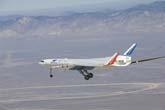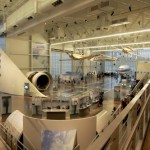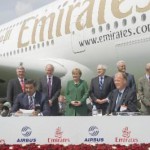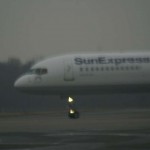The innovative Boeing [NYSE: BA] Blended Wing Body (BWB) research aircraft — designated the X-48B — flew for the first time last week at NASA’s Dryden Flight Research Center at Edwards Air Force Base in California.
CHICAGO — The 21-foot wingspan, 500-pound unmanned test vehicle took off for the first time at 8:42 a.m. Pacific Daylight Time on July 20 and climbed to an altitude of 7,500 feet before landing 31 minutes later.
„We’ve successfully passed another milestone in our work to explore and validate the structural, aerodynamic and operational efficiencies of the BWB concept,“ said Bob Liebeck, BWB program manager for Boeing Phantom Works, the company’s advanced R&D unit. „We already have begun to compare actual flight-test data with the data generated earlier by our computer models and in the wind tunnel.“
The X-48B flight test vehicle was developed by Boeing Phantom Works in cooperation with NASA and the U.S. Air Force Research Laboratory to gather detailed information about the stability and flight-control characteristics of the BWB design, especially during takeoffs and landings. Up to 25 flights are planned to gather data in these low-speed flight regimes. Following completion of low-speed flight testing, the X-48B likely will be used to test the BWB’s low-noise characteristics, as well as BWB handling characteristics at transonic speeds.
Two X-48B research vehicles have been built. The vehicle that flew on July 20 is Ship 2, which also was used for ground and taxi testing. Ship 1, a duplicate of Ship 2, completed extensive wind tunnel testing in 2006 at the Old Dominion University NASA Langley Full-Scale Tunnel in Virginia. Ship 1 will be available for use as a backup during the flight test program.
u003cp>Three turbojet engines enable the composite-skinned research vehicle to
fly up to 10,000 feet and 120 knots in its low-speed configuration.
Modifications would need to be made to the vehicle to enable it to fly at
higher speeds. The unmanned aircraft is remotely piloted from a ground
control station in which the pilot uses conventional aircraft controls and
instrumentation while looking at a monitor fed by a forward-looking camera
on the aircraft.u003c/p>
u003cp>The Boeing BWB design resembles a flying wing, but differs in that the
wing blends smoothly into a wide, flat, tailless fuselage. This fuselage
blending helps to get additional lift with less drag compared to a
circular fuselage. This translates to reduced fuel use at cruise
conditions. And because the engines mount high on the back of the
aircraft, there is less noise inside and on the ground when it is in
flight. u003c/p>
u003cp>"While Boeing constantly explores and applies innovative technologies
to enhance its current and next-generation products, the X-48B is a good
example of how Boeing also looks much farther into the future at
revolutionary concepts that promise even greater breakthroughs in flight,"
said Bob Krieger, Boeing chief technology officer and president of Phantom
Works. u003c/p>
u003cp>While a commercial passenger application for the BWB concept is not in
Boeing's current 20-year market outlook, the Advanced Systems organization
of Boeing Integrated Defense Systems' (IDS) is closely monitoring the
research based on the BWB's potential as a flexible, long-range,
high-capacity military aircraft. u003c/p>
u003cp>"The BWB concept holds tremendous promise for the future of military
aviation as a multi-purpose military platform in 15 to 20 years," said
Darryl Davis, Boeing IDS Advanced Systems vice president and general
manager of Advanced Precision Engagement and Mobility Systems. "Its unique
design attributes will result in less fuel burn and a greatly reduced
noise footprint, which are important capabilities to offer our Air Force
and mobility customers."“,1]
);
//–>
Three turbojet engines enable the composite-skinned research vehicle to fly up to 10,000 feet and 120 knots in its low-speed configuration. Modifications would need to be made to the vehicle to enable it to fly at higher speeds. The unmanned aircraft is remotely piloted from a ground control station in which the pilot uses conventional aircraft controls and instrumentation while looking at a monitor fed by a forward-looking camera on the aircraft.
The Boeing BWB design resembles a flying wing, but differs in that the wing blends smoothly into a wide, flat, tailless fuselage. This fuselage blending helps to get additional lift with less drag compared to a circular fuselage. This translates to reduced fuel use at cruise conditions. And because the engines mount high on the back of the aircraft, there is less noise inside and on the ground when it is in flight.
„While Boeing constantly explores and applies innovative technologies to enhance its current and next-generation products, the X-48B is a good example of how Boeing also looks much farther into the future at revolutionary concepts that promise even greater breakthroughs in flight,“ said Bob Krieger, Boeing chief technology officer and president of Phantom Works.
While a commercial passenger application for the BWB concept is not in Boeing’s current 20-year market outlook, the Advanced Systems organization of Boeing Integrated Defense Systems‘ (IDS) is closely monitoring the research based on the BWB’s potential as a flexible, long-range, high-capacity military aircraft.
„The BWB concept holds tremendous promise for the future of military aviation as a multi-purpose military platform in 15 to 20 years,“ said Darryl Davis, Boeing IDS Advanced Systems vice president and general manager of Advanced Precision Engagement and Mobility Systems. „Its unique design attributes will result in less fuel burn and a greatly reduced noise footprint, which are important capabilities to offer our Air Force and mobility customers.“
u003cp>NASA's participation in the project is focused on fundamental,
edge-of-the-envelope flight dynamics and structural concepts of the BWB.
Along with hosting the X-48B flight test and research activities, NASA
Dryden provided engineering and technical support — expertise garnered
from years of operating cutting-edge unmanned air vehicles.u003c/p>
u003cp>The two X-48B research vehicles were built by Cranfield Aerospace Ltd.,
in the United Kingdom, in accordance with Boeing requirements.u003c/p>
u003cdiv>###u003c/div>
u003cdiv>Contact Info:u003cbr>
u003cdiv>Tom Koehleru003cbr>Boeing Engineering, Operations &
Technologyu003cbr>(206) 766-2923u003cbr>u003ca hrefu003d“mailto:thomas.j.koehler@boeing.com“ targetu003d“_blank“ onclicku003d“return top.js.OpenExtLink(window,event,this)“>thomas.j.koehler@boeing.comu003c/a>
u003c/div>
u003cdiv>Daryl Stephensonu003cbr>Boeing Engineering, Operations
& Technologyu003cbr>(314) 232-8203u003cbr>u003ca hrefu003d“mailto:daryl.l.Stephenson@boeing.com“ targetu003d“_blank“ onclicku003d“return top.js.OpenExtLink(window,event,this)“>daryl.l.Stephenson@boeing.comu003c/a>
u003c/div>u003c/div>u003c/font>u003c/td>u003c/tr>
u003ctr>
u003ctd valignu003d“top“ alignu003d“middle“>
u003cdiv>u003ca hrefu003d“http://www.boeing.com/companyoffices/aboutus/site_terms.html“ targetu003d“_blank“ onclicku003d“return top.js.OpenExtLink(window,event,this)“>Site
Termsu003c/a> | u003ca hrefu003d“http://www.boeing.com/companyoffices/aboutus/privacy.html“ targetu003d“_blank“ onclicku003d“return top.js.OpenExtLink(window,event,this)“>Privacy
Policyu003c/a> | u003ca hrefu003d“http://www.boeing.com/contacts/“ targetu003d“_blank“ onclicku003d“return top.js.OpenExtLink(window,event,this)“>Contact Usu003c/a> | u003ca hrefu003d“http://www.boeing.com/companyoffices/aboutus/site_terms.html#copyright“ targetu003d“_blank“ onclicku003d“return top.js.OpenExtLink(window,event,this)“>Copyrightu003c/a>
u003ch6>Copyright 1995 – 2006 Boeing. All Rights
Reserved.u003c/h6>u003c/div>u003c/td>u003c/tr>u003c/tbody>u003c/table>
u003cdiv> u003c/div>
u003cdiv> u003c/div>
u003chr>
u003c/div>
„,0]
);
//–>
NASA’s participation in the project is focused on fundamental, edge-of-the-envelope flight dynamics and structural concepts of the BWB. Along with hosting the X-48B flight test and research activities, NASA Dryden provided engineering and technical support — expertise garnered from years of operating cutting-edge unmanned air vehicles.
The two X-48B research vehicles were built by Cranfield Aerospace Ltd., in the United Kingdom, in accordance with Boeing requirements.






